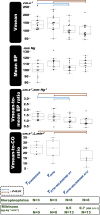Cerebral Vasospasm After Subarachnoid Hemorrhage: Respective Short-Term Effects of Induced Arterial Hypertension and its Combination With IV Milrinone: A Proof-of-Concept Study Using Transcranial Doppler Ultrasound
- PMID: 37720356
- PMCID: PMC10503695
- DOI: 10.1097/CCE.0000000000000973
Cerebral Vasospasm After Subarachnoid Hemorrhage: Respective Short-Term Effects of Induced Arterial Hypertension and its Combination With IV Milrinone: A Proof-of-Concept Study Using Transcranial Doppler Ultrasound
Abstract
Objectives: It is unclear whether IV milrinone relaxes spasmed cerebral arteries and therefore reduces cerebral blood mean velocity (Vmean). In patients treated for cerebral vasospasm, we aimed to assess and delineate the respective impacts of induced hypertension and its combination with IV milrinone on cerebral hemodynamics as assessed with transcranial Doppler.
Design: Observational proof-of-concept prospective study.
Setting: ICU in a French tertiary care center.
Patients: Patients with aneurysmal subarachnoid hemorrhage who received induced hypertension (mean arterial blood pressure [MBP] of 100-120 mm Hg) and IV milrinone (0.5 µg/kg/min) for moderate-to-severe cerebral vasospasm. We excluded patients who underwent invasive angioplasty or milrinone discontinuation within 12 hours after the diagnosis of vasospasm.
Interventions: None.
Measurements and main results: Vmean was measured at vasospasm diagnosis (TDIAGNOSIS), after the induction of hypertension (THTN), and 1 (THTN+MILRINONE_H1) and 12 hours after the adjunction of IV milrinone (THTN+MILRINONE_H12). Thirteen patients were included. Median Vmean was significantly lower (p < 0.01) at THTN+MILRINONE_H1 (99 [interquartile range (IQR) 89; 134] cm.s-1) and THTN+MILRINONE_H12 (85 [IQR 73-127] cm/s) than at TDIAGNOSIS (136 [IQR 115-164] cm/s) and THTN (148 [IQR 115-183] cm/s), whereas TDIAGNOSIS and THTN did not significantly differ. In all patients but one, Vmean at THTN+MILRINONE_H1 was lower than its value at TDIAGNOSIS (p = 0.0005). Vmean-to-MBP and Vmean-to-cardiac output (CO) ratios (an assessment of Vmean regardless of the level of MBP [n = 13] or CO [n = 7], respectively) were, respectively, similar at TDIAGNOSIS and THTN but were significantly lower after the adjunction of milrinone (p < 0.01).
Conclusions: The induction of arterial hypertension was not associated with a significant decrease in Vmean, whereas the adjunction of IV milrinone was, regardless of the level of MBP or CO. This suggests that IV milrinone may succeed in relaxing spasmed arteries.
Keywords: Doppler; cerebrovascular circulation/drug effects; delayed ischemia; intracranial; milrinone; subarachnoid hemorrhage; transcranial; ultrasonography; vasospasm.
Copyright © 2023 The Authors. Published by Wolters Kluwer Health, Inc. on behalf of the Society of Critical Care Medicine.
Conflict of interest statement
Dr. Lakhal received, during the past 3 years, congress registration from Pfizer (once in 2022) and both congress registration and travel fees from Pfizer (once in 2020) and Advanz Pharma/Correvio (twice, in 2020 and once in 2021). Dr. Rozec received, during the past 5 years, lecture fees from Fisher and Paykel, Baxter, Laboratoire du Fractionnement et des Biotechnologies, and Aspen, research grants from Baxter and Aguettant, and consulting fees from Laboratoire du Fractionnement et des Biotechnologies, Aguettant, and Astra Zeneca. The remaining authors have not disclosed any potential conflicts of interest.
Figures

References
-
- Picetti E, Bouzat P, Bader MK, et al. : A survey on monitoring and management of cerebral vasospasm and delayed cerebral ischemia after subarachnoid hemorrhage: The Mantra study. J Neurosurg Anesthesiol 2023. [Online Ahead of Print] - PubMed
-
- Lakhal K, Hivert A, Alexandre P-L, et al. : Intravenous milrinone for cerebral vasospasm in subarachnoid hemorrhage: The MILRISPASM controlled before-after study. Neurocrit Care 2021; 35:669–679 - PubMed
-
- Velly LJ, Bilotta F, Fàbregas N, et al. ; European Neuroanaesthesia and Critical Care Interest Group (ENIG): Anaesthetic and ICU management of aneurysmal subarachnoid haemorrhage: A survey of European practice. Eur J Anaesthesiol 2015; 32:168–176 - PubMed
LinkOut - more resources
Full Text Sources
Miscellaneous

